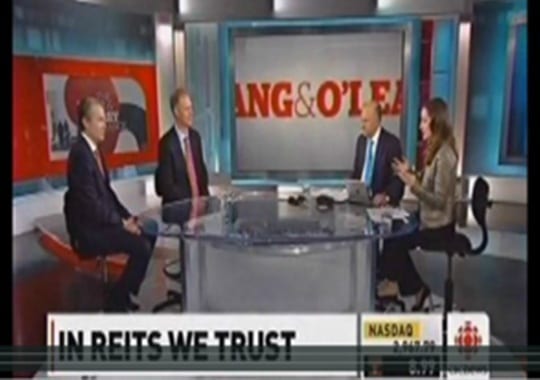Transcript of the Lang and O’Leary Exchange – November 27, 2012
Lang: The popularity of real estate investment trusts is growing. Total market cap is nearly doubled over the past two years alone. With changing demographics and investor demand it might not be long before it doubles again.
Ian Gragtmans is an executive vice president with Colliers International. Jay Cornforth is the president at Prologis. Great to have both of you here.
Ian and Jay: Thanks for having us.
Lang: So let’s talk about what’s been driving this and weather that’s going to change anytime soon Ian. We know there has been an interest in income generating and yielding product and that REITs fall nicely into that product category. Is that likely to continue in your view?
Ian: I think so. Equities have been having a tough run so I think a few thing shifting demographics. Those that are aging are looking for more capital preservation and perhaps they see that in hard assets. Hedge fund inflation could be another reason why they continue to be in favour now. A number of different reasons and I think again that perhaps the last meaning or important one is the equity markets are not doing so hot so I think the people are looking at the yield that are provided by some of these REITs and thinking that they like that and it’s stable.
O’Leary: So Jay, let’s talk about what happens to REITs when rates go up because in the next two years it’s highly likely that we’ll start to see the first rate hikes.
Jay: I think that there is a couple of things going on. When you really look at where cap rates are today to acquire real estate on the commercial side. Cap rates are fairly elevated when you compare it to long term debt. So I think even if debt moves up a little bit the spread is still healthy today. About four to five hundred basis points. So I’m not convinced that you are going to see any type of cap rate expansion if rates move up about a hundred basis points. The other thing I think going on with real estate today is it’s a natural hedge. Our easy money policy today globally is really a natural hedge with real estate.
Lang: Is there a difference between residential and commercial REITs if people are thinking about exposure here. Do they move similarly if rates go up or is one likely to be protected more from the market than the other?
Ian: I think that first of all on the comment on the residential side. In all fairness our expertise is in commercial, industrial and retail side but on the residential side there has been these fantastic articles throughout the media that suggest we are headed towards a bust on the residential side. There is a softening at best. The reality is that there is a quarter of a million people coming into this country every year. Half of them roughly are coming to Toronto. They need a place to live and we don’t have this colossal over expansion or over building problem that they have had in many markets in the US. So I think the residential side will be fine. On the industrial, commercial and retail side, the supply and demand ratios are healthy. Across the country there is a roughly 5 percent vacancy on the office side. Industrial isn’t that far off of that. Off the top of my head I can’t think of the retail vacancy numbers but bottom line both sides, the ICR and the residential are relatively secure. What drives an investor to go to the residential side versus the commercial side is a very good question. Jay, perhaps you have an answer for it, unfortunately I don’t.
O’Leary: Talking about REITs let me ask you something. Wouldn’t I want a REIT that has pricing power, like a hotel REIT that can change their rates if rates are going to go up and if we experience more economic activity? Why would I want to be stuck in a REIT that is stuck in long leases of offices?
Jay: Well I think it varies by what the investor really needs. So I think every investor will have a different need and if an investor is looking for maybe a shorter term investment horizon then maybe that would be where they want to invest. Every investment is a little bit different in that regard.
Lang: What we worry about right now is the possible United States recession. If they really do not resolve the fiscal situation we may see another drag there. Is there a connection we can draw between the housing market here and what happens there? Or I guess in other words, our overall economy and what happens to the REIT space.
Jay: Again, we are concerned. There is no doubt that we have some global headwinds with the fiscal cliff in the United States. That is a drag on potential underlying demand. So there is definite concern there. However, you have to take a long-term view when you look at real estate and I think the demographics are shifting. I think it’s a good hedge. It’s a hard asset and I think investors are looking for yield. And I think we are in for a very low investment yield environment for a long period of time. So when you can go out and buy a Canadian REIT with a five percent or six percent dividend yield this is pretty attractive and it’s stable.
Lang: So what is the part of the market that you are seeing the most growth in right now? Because there may be a sense that it may be a little overbought, for the reasons we just said: it’s been really attractive, they are looking for yield and hard assets. Where is there still value to be had in your view Ian?
Ian: Good question. You have a whole lot of REITs in Canada versus the United States. There is the capital wall, as everyone likes to use that terminology, that’s out there looking for commercial, industrial and retail investments throughout the country is huge. We’re pretty small and there is not that much product availability to be had, so a couple of things are happening. One, they are going to, um, we refer to something called a flight equality or the type of product or tenant if you will that is in a building. So investment grade tenant and investment grade product would be let’s say your A class. We are seeing a flight towards B class just because there is no A class to be had. So I don’t think there is any of the markets are going to take a downfall because there is just too much demand. If you just spin off of what Jay said, I think there is going to be a bit more cap rate compression versus expansion. And I think that we know that the number of new entrants in the investment market looking for product in Canada is enormous. Seemingly every month there is a new one that comes out, so what they’re doing now is that they can’t deploy in Canada so they are going to the United States looking for opportunity there.
Lang: Alright. We have to leave it there. Thank you to both of you for being here today with us.
Ian and Jay: Thanks for having us.


